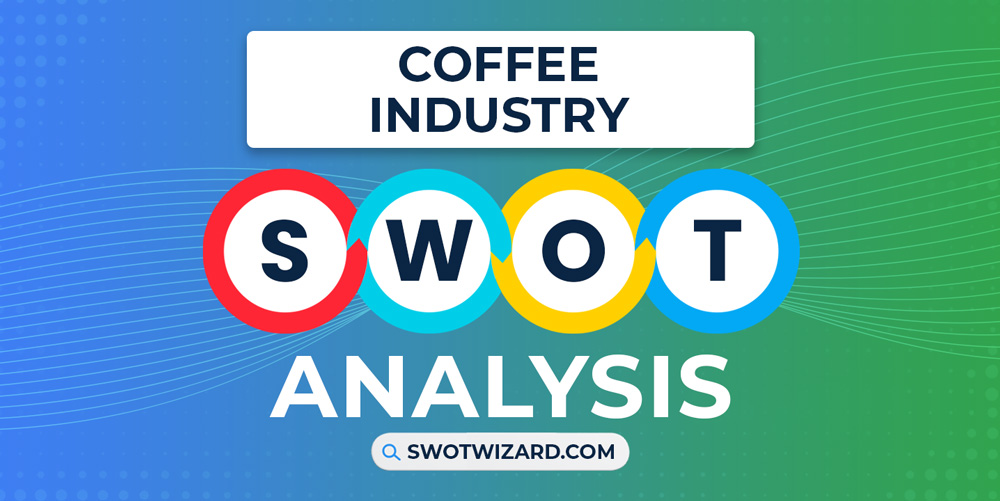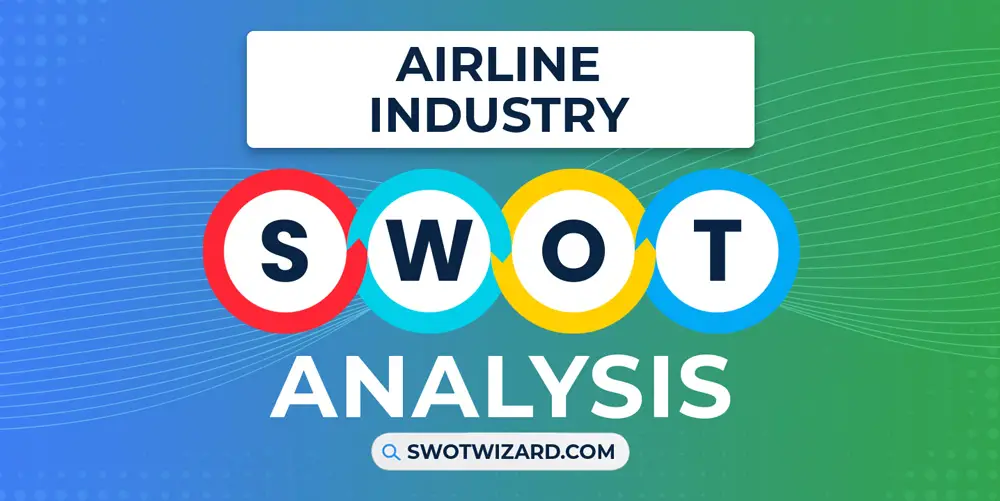The coffee industry has reached every part of the world in every class of people, becoming a part of our daily lives. Even while I’m sharing this with you, I’m enjoying my cup of coffee, and I hope you’re also reading this while enjoying yours. Here, we will discuss it in this coffee industry SWOT analysis.
Coffee Industry Overview
For centuries, coffee has served as more than just a beverage; it has been a driving force of connection, culture, and community. As a result, the global coffee industry has experienced steady growth over the past decade, reaching a market value of over $126.17B in 2023.
Coffee consumption continues rising worldwide, estimated to reach over 160M bags by 2025, driven by demand across both traditional and emerging markets, and Brazil, Vietnam, Colombia, and Indonesia represent the leading producers, catering to millions of people.
Competitors in Coffee Industry
Starbucks | Dunkin’ | Tim Hortons | Dutch Bros. Coffee | JDE Peet’s Coffee And Tea | McCafé | Gloria Jeans Coffee | Costa Coffee | Lavazza | Caribou Coffee
Did You Know?
The term “coffee break” was popularized by a Pan-American Coffee Bureau ad campaign in the 1950s to encourage employees to take breaks and enjoy coffee.
Strengths – Coffee Industry SWOT Analysis
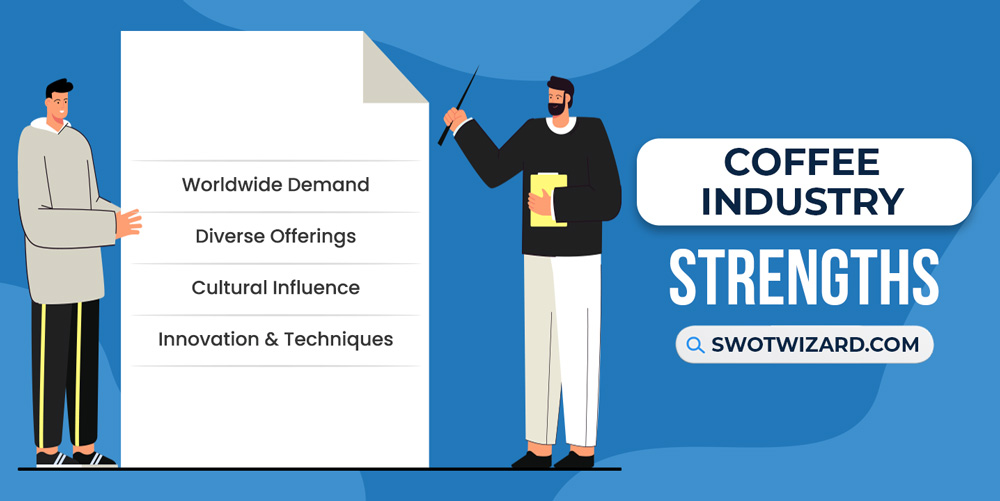
Worldwide Demand: Coffee’s universal appeal fuels an insatiable demand, evidenced by an estimated global market value of $126.38B in 2022 and a compound annual growth rate of 23.8% from 2023 to 2027. Approximately 2.25B cups of coffee are consumed daily globally, showcasing its enduring popularity and cultural significance.
Diverse Offerings: With an expansive spectrum of beans, blends, and brewing methods, the coffee industry caters to diverse palates. Innovations like cold brew and ready-to-drink coffees have also emerged, and not to mention artisanal roasters offer single-origin beans, providing an exceptional taste adventure.
Cultural Influence: Coffee transcends borders and possesses deep cultural significance, acting as a conduit for conversations and often associated with community connections. Before the modern era, coffee culture in places like Italy and Ethiopia exemplifies how it fosters social interaction and becomes part of the cultural fabric. In the modern era, chains like Starbucks and North End have also effectively commercialized the coffee culture and made it mainstream.
Innovation & Techniques: Ongoing innovation in techniques and technology has improved coffee quality and accessibility, and as a result, it abounds, from cold brews to nitrogen-infused coffee. We can see many options nowadays, such as espresso machines, single-serve pods, roasting advancements, and e-commerce delivery models, championing new techniques for the ultimate coffee experience.
Weaknesses – Coffee Industry SWOT Analysis
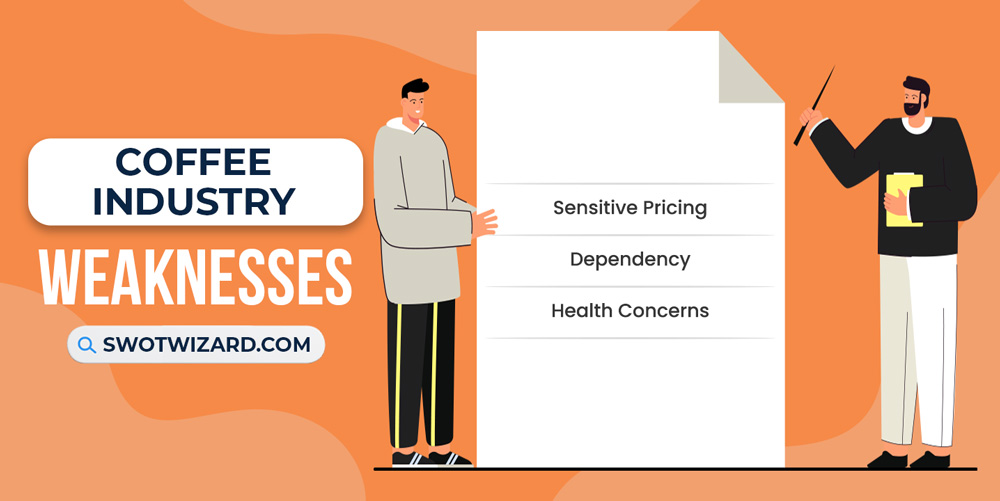
Sensitive Pricing: Coffee prices and production are highly sensitive to unpredictable factors like weather and climate change, evidenced by severe frosts in Brazil causing global price spikes. If we look at the data from the last few years, coffee futures prices surged by over 40% due to concerns about Brazilian coffee crops, impacting global coffee prices and making reliable sourcing and budgeting difficult for industry players.
Dependency: Many producing countries depend heavily on coffee exports, comprising over 50% of export earnings for some. As a result, internally, the stakeholders in the coffee industry are in a weak position, and dependency on a single commodity leaves farmers economically vulnerable to price fluctuations. According to historical data, Brazil, the world’s largest coffee producer, faced severe droughts in 2014-2015, resulting in a sharp drop in coffee production by 30%.
Health Concerns: Concerns exist around the potential health impacts of coffee, though research remains inconclusive. As a result, it has led to concerns about caffeine consumption. According to some studies, the WHO associated very hot beverage consumption, including coffee, with higher esophageal cancer risk.
Opportunities – Coffee Industry SWOT Analysis

B2C Model: Direct-to-consumer and e-commerce models provide opportunities to build closer customer relationships and capture more value, as seen in the rise of small-batch roasters selling online. Many coffee shops already utilize this opportunity, such as Starbucks leveraging its mobile app for orders and payments. According to data, it has over 20M active mobile app users in the USA alone, showcasing the viability of this approach.
Market Expansion: When a country’s income level increases, so do the spending and the overall lifestyle, and coffee is a part of everyday lifestyle. Developing countries are perfect as they offer considerable market expansion opportunities and exhibit significant untapped potential. If we look at the data, India’s coffee consumption is forecast to grow at a CAGR of 9.04% from 2023-2028 as coffee culture expands.
Efficient Supply Chain: Optimizing the supply chain through transparency, blockchain, relationship coffee models, and eliminating intermediaries could benefit farmers and consumers. Besides, Streamlining the supply chain can drive cost savings as Nestlé and Starbucks did. By consolidating their retail products under Nestlé, they’ve optimized production and distribution globally, enhancing efficiency.
New Offerings: Product innovations like ready-to-drink cold brew and nitro coffee cater to consumer preferences for convenience and new experiences. The global RTD coffee market alone could reach $35B by 2025, and the cold brew coffee market was valued at $822.01M, with a predicted CAGR of 22.72% from 2022 to 2028.
Threats – Coffee Industry SWOT Analysis
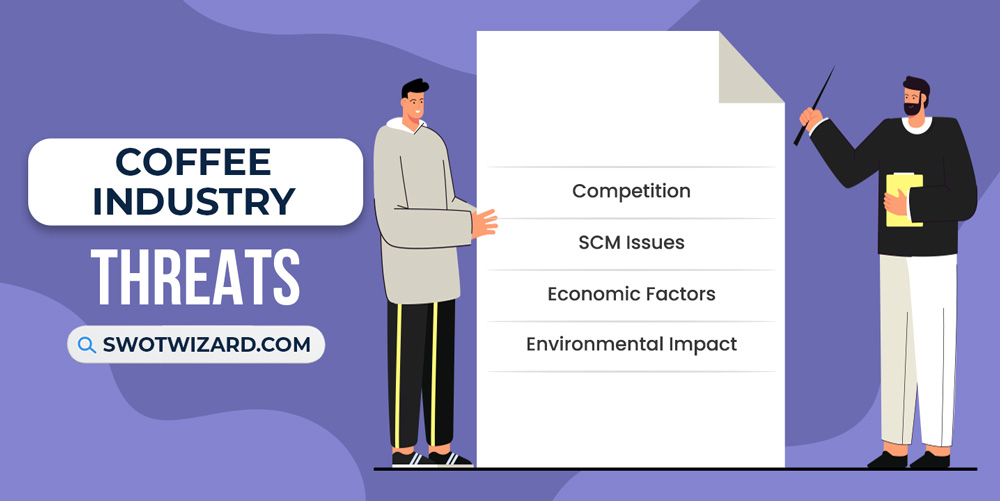
Competition: Coffee faces increasing competition from other beverages like energy, ready-to-drink teas, plant-based milk alternatives, and functional drinks. Global energy drink sales grew to $86.35B in 2021 from $43B in 2016. Besides, Nimble startups like Blue Bottle and Stumptown Coffee have disrupted the market with premium offerings, challenging established players.
SCM Issues: Complex global supply chains with many intermediaries lead to a lack of transparency, uneven profit distribution, and reduced sustainability. Besides, maintaining consistent quality from coffee farms to consumers is challenging, leading to concerns about product consistency. As a result, only $0.09 per pound reaches farmers on average for green coffee exports.
Economic Factors: Economic downturns and reduced consumer discretionary spending may limit industry growth temporarily, as we have seen in 2020 when the price of Arabica beans fell to its lowest in 14 years due to a surplus, affecting profitability. And coffee demand dropped during the 2008 recession, which might happen again in the 2024 recession.
Environmental Impact: Climate change threatens future coffee production, with a predicted decline in areas suitable for Arabica coffee farming by up to 50% by 2050, according to some estimates. And there are also concerns about other things, as it can drive deforestation, as seen in regions like Vietnam, raising environmental concerns and potential regulatory restrictions.
[Bonus Infographic] SWOT Analysis of Coffee Industry
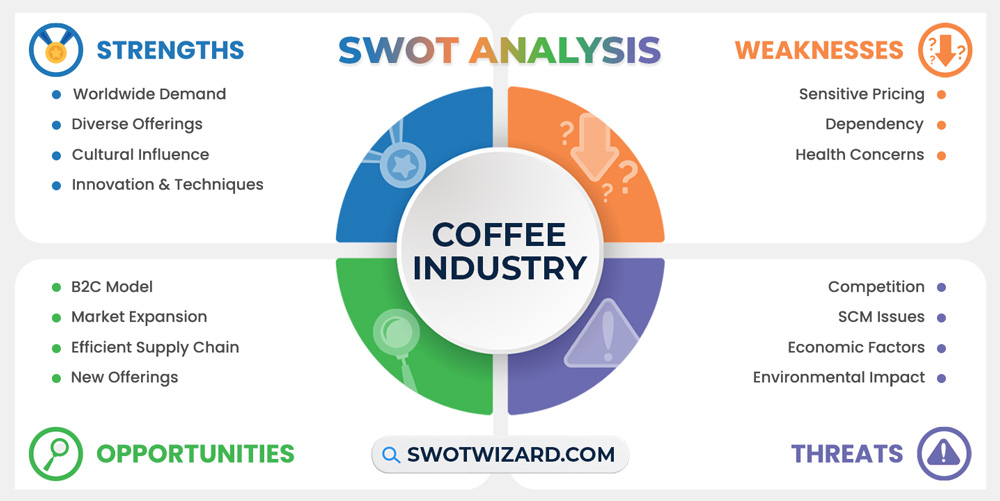
Recommendations for Coffee Industry
The coffee industry has too many stakeholders and layers between farmers and end consumers. The industry should take a few things seriously because too many things are at stake.
- Adopt direct-to-consumer and e-commerce models to build closer customer relationships and capture more value.
- Expand into high-growth markets like India and China as rising incomes drive greater coffee consumption.
- Streamline the supply chain by eliminating unnecessary intermediaries, implementing blockchain for transparency, and embracing relationship coffee models.
- Develop new product innovations like ready-to-drink cold brew and nitro coffee to align with consumer demand for convenience and new experiences.
Frequently Asked Questions (FAQs)
Who are the two largest producers of coffee?
The two largest producers of coffee are Brazil and Vietnam.
Which country loves coffee the most?
Australia loves coffee the most.
Final Words on Coffee Industry SWOT Analysis
The coffee industry faces a landscape of challenges and opportunities. While competition, supply chain complexities, economic factors, and environmental concerns pose threats, diversifying B2C models, exploring emerging markets, optimizing supply chains, innovating with new offerings, and enhancing customer experiences can position the industry for sustainable growth and resilience.
References
- Allen, L. (2023, July 7). Coffee Statistics: Consumption, preferences, & spending. Drive Research.
- Coffee culture from around the world that will make you fall in love with it all over again! (2020, January 8). The Times of India.
- Asplund, R. (2023, August 30). Weather concerns boost coffee prices. Nasdaq.

